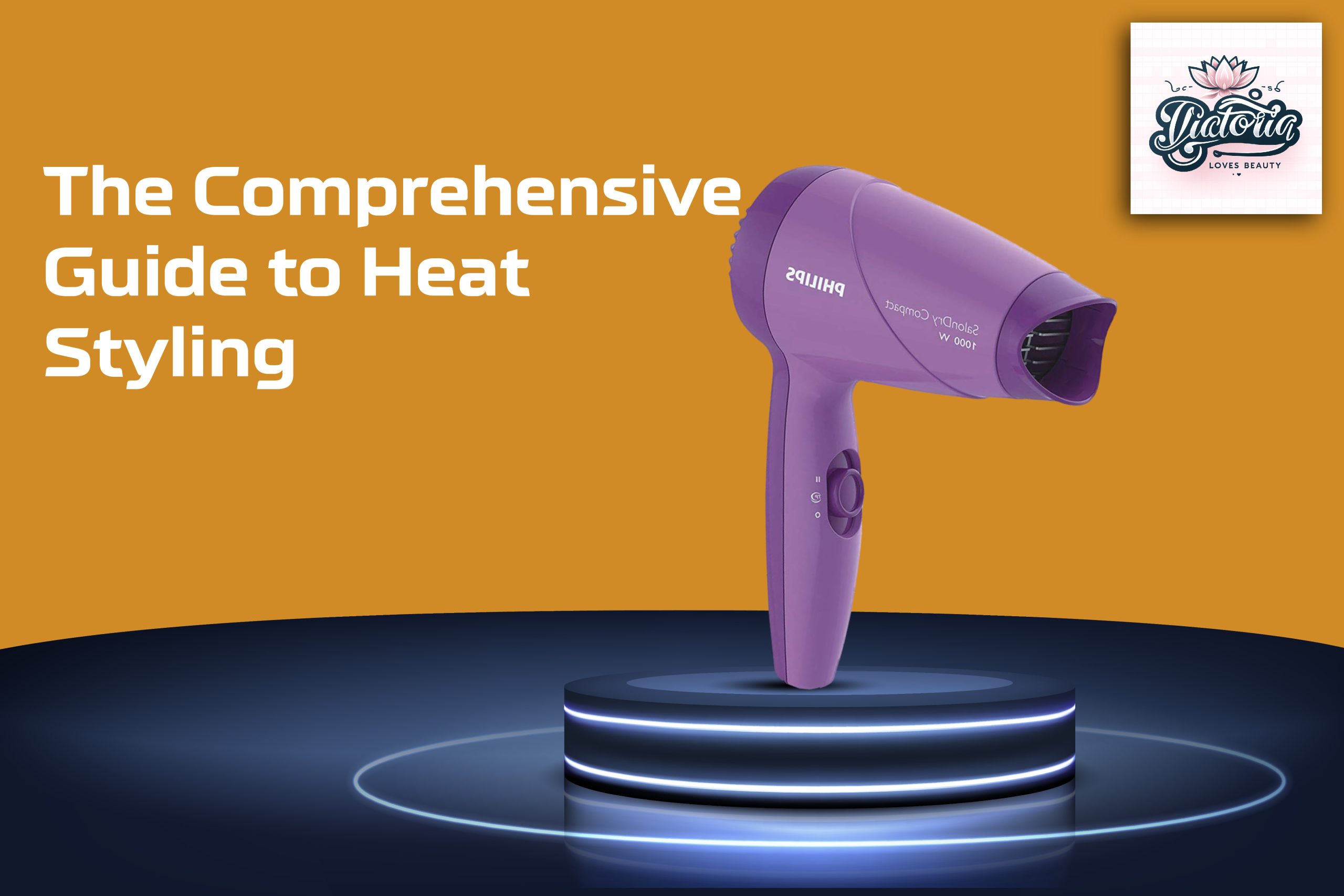In the world of hair care, heat styling is like a magician’s wand; it can transform frizzy chaos into smooth perfection or add a glamorous touch to gorgeous curls. It’s the go-to weapon we use to create our unique looks. The catch is that, like any magic trick, it requires a certain amount of precision. Let’s explore the behind-the-scenes heat styling techniques, and we’ll teach you how to master this transformational technique without sacrificing the health of your hair!
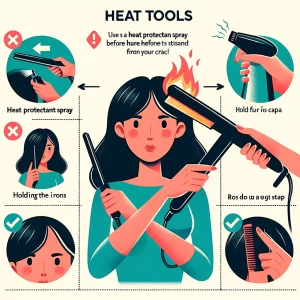
The Comprehensive Guide to Heat Styling
Hair styling tools like blow dryers, curling irons, and flat irons work by altering the natural hydrogen bonds in the hair. This process temporarily changes your hair’s structure, allowing you to reshape it as desired. However, excessive heat can cause significant damage. It can crack the hair’s cuticle layer – its protective shield – leading to dullness, dryness, and, in severe cases, breakage.
Knowing the ideal temperature range for your hair type and texture is crucial for safeguarding your priceless strands. While coarse or thick hair may take higher temps, fine hair may need lower heat settings. Applying a heat protectant product before style can serve as a barrier, lessening the damaging effects of heat on the structure of your hair.
Moreover, the method you employ while doing heat styling has great importance. The race is won by perseverance. Your hair will get an equal distribution of heat if you apply even pressure and move the styling tool at a steady speed, which lowers the chance of damage.
Types of Heat Styling Tools
Heat styling tools are essential for creating a variety of hairstyles, from sleek, straight looks to bouncy curls. Understanding the different types available and their specific uses can help you achieve your desired hairdo while minimizing damage to your hair.
Flat Irons (Straighteners)
- For straightening hair.
- Variants: Ceramic, Titanium, Tourmaline.
- Different plate sizes for hair length.
Curling Irons
- Create curls/waves.
- Various barrel sizes for curl types.
- Clip and clipless designs.
Blow Dryers
- Dry and style hair.
- Ionic, Ceramic, and Tourmaline technologies.
- Attachments like diffusers and concentrators.
Hot Air Brushes
- Combine drying and brushing.
- It’s ideal for smooth blowouts.
Crimping Irons
- Create crimped, textured hair.
- Serrated plates for waves.
Selecting the Right Temperature for Your Hair Type
Each hair type responds differently to heat:
- Fine Hair: This hair type is delicate and susceptible to heat damage. It’s recommended to use a temperature range of 260°F to 325°F. Fine hair has a smaller circumference and requires less heat for styling.
- Coarse Hair: Thicker and sturdier, coarse hair can tolerate higher temperatures, generally between 390°F and 410°F. This type of hair has a larger circumference and requires more heat to change its shape.
- Chemically Treated or Damaged Hair: If your hair has undergone chemical treatments or is already damaged, it’s crucial to be gentle. Keep the heat low, around 250-300°F (120-150°C), and prioritize hair health over high-temperature styling.
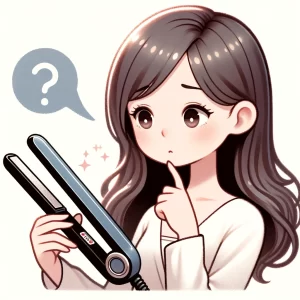
Always start with a lower temperature setting and only increase if necessary. Remember, less heat is often more when it comes to hair styling.
Heat Protectants Are Essential: Always use a high-quality heat protectant before styling, regardless of hair type. By acting as a barrier, these products lessen the damaging effects of heat on the hydration and structure of your hair.
Trial and Error: Finding the ideal heat setting could take some trial and error. Lower the temperature first, then raise it bit by bit until you have the desired look without causing too much damage.
The Importance of Heat Protection
To achieve a wide variety of gorgeous hairstyles, heat styling appliances, including flat irons, curling wands, and hairdryers, have become our reliable partners. Nevertheless, their high heat has two sides, both beneficial and harmful. Our hair needs a barrier from the searing heat of styling products, just as we protect our skin from the sun’s harmful rays. This is your comprehensive approach to protecting those priceless strands:
Thermal Protection Products: Investing in a top-notch thermal protectant is your hair’s first line of defense. Products like Sojourn Thermal Protect Spray are game-changers. The key is to opt for high-quality options that do more than protect. These superheroes maintain essential moisture levels in your hair, so avoid alcohol-based formulas. Many thermal protectants offer bonuses like UV protection and a brilliant shine boost.
Application Tips: Proper application is the secret to adequate protection. Whether your hair is damp or dry, evenly distribute the protectant throughout your locks. Run a comb through your hair to ensure every strand gets its fair share of protection. The best part? Quality products won’t leave any sticky residue on your hair or, even worse, on your beloved styling tools.
Unique Ingredients: When shopping for thermal protection products, watch for those with natural oils and nutrients in their ingredient list. For instance, buriti oil products shield your hair from searing heat and provide extra strength and resilience. These ingredients work wonders in fortifying your hair against the trials of styling.
Hair Care Post-Styling
Proper hair care after heat styling is crucial to maintain hair health and keep your style looking its best. Here are key points to consider:
Cool-Down: After using heat styling, let your hair cool down. This lessens frizz and helps establish the style.
- Hydrating Products: To restore moisture lost while styling, use hydrating serums or oils. Some excellent options include argan, coconut, or specialty hair serums.
- Avoid Wetting Right Away: After styling your hair, avoid washing or wetting it right away, as this can exacerbate hair damage and cause the style to fall out.
- Brush Gently: To minimize breakage, gently detangle hair using a wide-tooth comb or a brush with soft bristles.
- Moisturizing Treatments: Hair may be strengthened and repaired with regular deep conditioning treatments or hair masks.
- Minimize Touch-Ups: Make an effort to avoid using heat tools too much for touch-ups. More harm may result from overuse.
- Use Dry Shampoo: Dry shampoo absorbs more oil and adds volume to help your style last longer.
- Avoid Tight Hairstyles: Tight hairstyles can cause tension and pull on your hair, so stay away from them after heat styling.
Recognizing and Preventing Heat Damage:
Your hair is your greatest asset, but it’s also quite sensitive, and too much heat can cause it to lose its resilience and shine. It’s critical to identify the warning signs of heat damage and take preventative action to keep your locks looking their best. This is your SOS guide to maintaining the health and vibrancy of your hair:
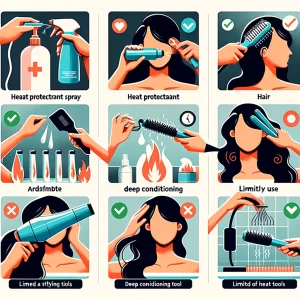
Knowing the Signs of Heat Damage is Essential:
- Dryness and Dullness: Excessive heat can be a ruthless thief, robbing your hair of its natural moisture. If your once-shiny mane has lost its sparkle and feels dry to the touch, it could be a telltale sign of heat damage.
- Increased Breakage: Healthy hair should be firm and resistant to breakage. If you notice more hair breakage than usual, especially when brushing or styling, it indicates that your hair may suffer from too much heat.
- Change in Texture: Over-styled hair may undergo a noticeable transformation in texture. It might become rougher, less silky, and lose its natural elasticity. These changes are often attributed to the weakening of hair bonds caused by excessive heat.
- Difficulty in Styling: Healthy hair should be flexible and hold styles well. If your hair no longer responds to your styling efforts as it once did, it’s a sign that heat damage may have compromised your hair structure.
Prevention is Key:
- Lower the Heat: One of the most effective ways to prevent heat damage is to reduce the temperature settings on your styling tools. Always start with the lowest adequate heat and gradually increase only as needed.
- Use Quality Heat Protection: A high-quality heat protectant is a barrier between your hair and the styling tool’s heat. It’s your hair’s first line of defense, so make it a non-negotiable part of your routine.
- Limit Heat Styling Frequency: Give your hair regular breaks from heat styling. Embrace natural hairstyles or lower-heat alternatives like air-drying whenever possible.
- Invest in Quality Tools: High-quality styling tools with even heat distribution can minimize damage. Cheaper, less reliable tools often require higher temperatures to achieve the same results.
- Deep Conditioning: Regular deep conditioning treatments can help repair and strengthen heat-damaged hair. Look for products with ingredients like keratin or protein for added benefits.
Tips for Effective Heat Styling
Your key to magnificent, head-turning hairstyles may be heat styling. However, to guarantee that your hair stays healthy and vibrant, it must be done carefully and use the proper techniques, just like any great art form. The following priceless advice will help you become an expert in the art of efficient heat styling:
Gradual Temperature Increase: Consider heat styling as a soft build-up. Your styling tools’ temperature should progressively increase from a lower setting to a higher one as needed. This reduces the possibility of damage occurring immediately and lets you choose the right amount of heat for your particular hair type and style.
Continual Trims: Regular hair trimming is a great way to keep your haircut looking nice and an effective way to avoid split ends brought on by heat style. Your hair will stay robust and durable if you trim those ragged ends.
Avoid Daily Heat Styling: Give your hair a rest period. Daily overuse of heat-styling equipment can cause cumulative harm. Accept natural hairstyles or lower-heat substitutes wherever possible to let your hair recover and rejuvenate.
Use Quality Tools: Purchasing superior styling tools is like purchasing an expensive paintbrush for an artwork. To better control the heat, look for instruments with temperature settings that you can modify. Ceramic or tourmaline plates are great options because they disperse heat more evenly and lessen the possibility of hot spots that might harm your hair. In addition to being more durable, high-quality tools are an excellent investment in your hair’s health and your style ability.
Make Heat Protection a Priority: Only leave the house with your go-to heat shield. Using a high-quality heat protectant is a must. It ensures the safety of your hair while improving the style process by forming a layer of protection between it and the heat of the styling instrument.
Trends in Heat Styling
New inventions and trends are constantly changing the field of heat styling. The following are some of the newest trends in heat styling:
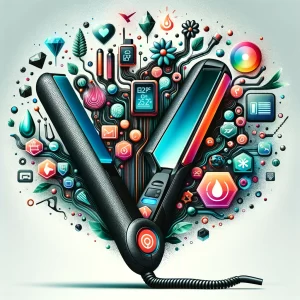
- Tools with various uses: There’s a rising trend toward multipurpose tools that may be used for drying and styling simultaneously or for curling and straightening. These adaptable tools are ideal for
producing a range of styles with minimal mess. - Cordless Technology: Cordless hair tools are becoming increasingly popular because of their mobility and ease of use. They come in particularly useful for on-the-go touch-ups or traveling.
- Eco-friendly and Energy-efficient equipment: As environmental responsibility gains momentum, so does the need for eco-friendly styling equipment. These consist of instruments built of sustainable materials and energy-efficient designs.
- Digital and Smart Features: To provide individualized style experiences, advanced heat styling tools now include intelligent features like AI integration, Bluetooth connectivity, and automated temperature adjustment based on hair type.
- Natural Textures and Less Heat Styling: It’s fashionable to embrace natural hair textures, which has led to the rise in demand for products that accentuate rather than change natural patterns. Additionally, there’s a trend toward employing colder temperatures to reduce hair damage.
Final Thoughts
Prioritizing safety above everything else is crucial when using heat-styling products. This includes using tools in the proper settings, reading and following safety warnings, and storing them properly. Vigilance is essential since failing to take these precautions might have profound implications, such as bodily harm or hair damage.
- Safety First: Always prioritize safety by using heat-styling tools correctly and following instructions.
- Stay Informed: Keep up with the latest in heat styling technology and trends for better results.
- Choose Wisely: Pick the right tools and techniques suited to your hair type and desired style.
- Protect Your Hair: Use heat protectants to shield against damage and maintain hair health.
- Right Temperature: Know the ideal heat setting for your hair type to avoid over-styling.
- Moderate Use: Use heat tools sparingly to preserve your hair’s integrity.
- Aftercare: Invest in after-styling maintenance like moisturizing treatments to help hair recover.
- Balance is Key: Strike a balance between achieving styles and keeping your hair healthy.
- Empowered Styling: Use this guide to make informed decisions for confident and safe heat styling.

Beauty enthusiast, mom on-the-go, and coffee addict (not necessarily in that order!). When she’s not chasing after her adorable toddler, Victoria is busy researching the latest beauty trends, testing out products, and sharing her discoveries with the world. Join her on this journey of self-care, empowerment, and finding your own unique spark of beauty!
